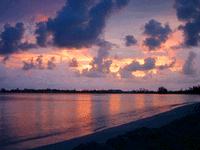



Grand Bahama is an island paradise conveniently located less than 100 miles from Miami. The island is well known for its rambling, reef-protected shoreline with its many cays and white-sand beaches. It is this close proximity to the United States that has stimulated the development of the island's many resorts and casinos. Spring Break Travel and Student City are the primary tour operators for this island resort. They book most of the available space on the cruiseship Discovery, which provides transportation to the island daily, and thus they handle most of the available rooms during the season.

When you arrive on Grand Bahama Island, you will discover that there are two different types of beaches. Lucaya Beach, Xanadu Beach, and Taino Beach, which are adjacent to the hotels and resorts, provide activites like parasailing, snorkeling, and windsurfing, but the island also has many secluded beaches to be found by adventurous Spring Breakers. The recommended mode of transportation is by moped or scooters, which can be rented by the day or half-day. One of the most spectacular stretches of beach is Gold Rock Beach on the eastern end of the island. It is part of the 40 acre Lucayan National Park, which is also known for its many caves and is only one of the many eco-tourism sites on the eastern end of the island.
When you get tired of exploring the beaches, you can go hang out with a pod of Atlantic bottlenose dolphins at the (UNEXSO). Scuba training is available and they offer snorkling and dive packages for individuals and groups. They have a decompression chamber on premises that might help your recovery if you have a really bad hangover. If you want to expore the Grand Bahama's underwater life, but don't want to get your feet wet, The Mermaid Kitty (said to be the world's largest glass bottom boat) has daily sightseeing tours.
Most tourists also find their way to the many shops on the island. While you are down near the UNEXSO dock, you will also find the Port Lucaya Marketplace and Marina with its upscale shopping, dining, and amusement center. Adjacent to the casino, you will find the International Bazaar and the Straw Market. The International Bazaar has several shops and boutiques and with products from a variety of countries. There is also the Straw Market with hats, mats, and baskets, and other local trinkets to be found in shops around the island.
Freeport/Lucaya would not qualify as a Spring Break destination if it didn't have an abundent supply of nightime activities. In addition to the hotel bars, the Port Lucaya Marketplace has over a half a dozen different bars and pubs to explore. You will also want to check out the music in Count Basie Square. There is an ample supply of nitespots, where you can get a taste of the local sounds, find several discos where you can dance almost 'til dawn, and visit two casinos with virtually non-stop action. And you can always find a beachside bar, where you can toss back Bahama Mamas and enjoy the moonlight beach.
You will find that food is moderately priced as in any resort area. It does need to be flown over from the U.S., so it is a little bit more expensive than usual. Fast food like Burger King, Subway, Wendy's, and KFC are available and are not that much more than what you would find in the States. Sit-down restaurants can be expensive depending on where you go and what you order.
The island's first commercial development occured during the American Civil War. The Union's blocade of the Confederate's seaports made the fishing village of West End an essential waypoint for smugglers. The island's second economic boom began immediatlely after the passing of the 14th Amendment by the United States Congress. Warehouses sprang up overnight to meet the need for a transfer point where liquor from Canada, England, Mexico, and Nassau could be stored and packaged before smugglers made the journey to the U.S.
The Bahamas' convenient location makes the islands a popular destination for American tourists. Modeled after the "Cuban tourist experience" of the 1950's, the port of Freeport and the Lucaya resort area were initally conceived on paper in 1955. The island has been commercially developed as a destination where you can enjoy a tropical paradise but still have all of the amenities and activities of a "european style" resort. Since the opening of the first tourist hotel in 1964, Freeport/Lucaya has grown to be the second largest city in the Bahamas.